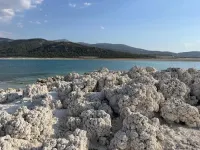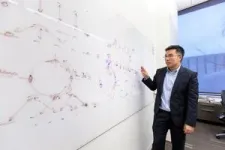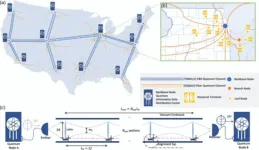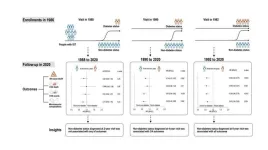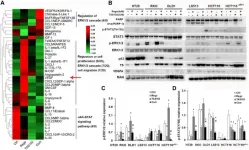(Press-News.org) Despite decades of research, there’s still much scholars don’t understand about life’s beginnings and early evolution. A UC Riverside paper has opened the door to understanding more and to framing future studies that could help predict climate change and search for life beyond Earth.
“This paper strives to inform the Earth sciences community where the research needs to go next,” said Christopher Tino, a UCR PhD candidate during the time of research and a first author.
Many studies have explored signs of early life preserved in ancient rocks, but this paper, recently published in the journal Nature Reviews Microbiology, weaves together this data with genomic studies of modern organisms and recent breakthroughs about the evolving chemistry of the early oceans, atmosphere, and continents.
The paper shows how Earth’s earliest life forms — microbes such as O2-producing bacteria and methane-producing archaea — shaped, and were shaped by, changes in the oceans, continents, and atmosphere.
“The central message in all of this is that you can't view any part of the record in isolation,” said Timothy Lyons, a UCR distinguished professor of biogeochemistry and co-first author. “This is one of the first times that research across these fields has been stitched together this comprehensively to uncover an overarching narrative.”
Bringing together experts in biology, geology, geochemistry, and genomics, the paper details the journey of Earth’s early life forms from their first appearances to their rise to ecological prominence. As their numbers increased, microbes began to affect the world around them, for instance by starting to produce oxygen via photosynthesis.
The findings across each field often “agree in remarkable ways,” according to Tino, who is now a postdoctoral associate at the University of Calgary.
Specifically, the study tracks how microbial life consumed, transformed, and dispersed key nutrients containing nitrogen, iron, manganese, sulfur, and methane across Earth. These biological pathways evolved as Earth’s surface changed dramatically along with, and sometimes because of, new life. Continents emerged, the sun became brighter, and the world became rich in oxygen.
Because the evolution of new biological pathways affected these element cycles, their trajectories tell us when early life forms appeared, how they affected and responded to the environment, and when they developed global-scale ecological footprints.
Rocks billions of years old often lack the visible fossils needed to tell the whole story, but this study incorporated the chemistry of these rocks and the genomes of living relatives to form a comprehensive view of ancient life.
“In essence, we are describing Earth’s first flirtations with microbes capable of changing the global environment,” said Lyons, who is also the director of the Alternative Earths Astrobiology Center in the Department of Earth and Planetary Sciences. “You need to understand the whole picture to fully grasp the who, what, when, and where as microbes graduated from mere existence to having a significant effect on the environment.”
Many scholars have assumed that once a life form appeared on Earth, it quickly became prolific. Only by bringing together decades of research across disciplines, as Lyons, Tino, and their colleagues did in this paper, can scientists see the difference between the mere presence, versus the dominance, of certain microbes. Often, the rise from existence to prominence took hundreds of millions of years.
“Microbes that at first eked out an existence in narrow niches would later have their turn to be the big kids on the block,” said Lyons.
All this distills down to the basic question that keeps the UCR team awake at night: Where did we come from?
But the answers gleaned from this research also have more practical applications, including insights into how life and environments might respond to climate change, both in the short term and far future.
The study could also aid the search for life on other planets. “If we are ever going to find evidence for life beyond Earth, it will very likely be based on the processes and products of microorganisms, such as methane and O2,” said Tino.
“We are motivated by serving NASA in its mission,” Lyons noted, “specifically to help understand how exoplanets could sustain life.”
Lyons and Tino were joined in this effort by Gregory P. Fournier, Massachusetts Institute of Technology; Rika E. Anderson, University of Washington and Carleton College; William D. Leavitt, Dartmouth College; Kurt O. Konhauser, University of Alberta; and Eva E. Stüeken, University of Washington and University of St. Andrews.
END
Exponentially increasing understanding of early life on Earth
UCR study could shape the search for life on other planets
2024-07-09
ELSE PRESS RELEASES FROM THIS DATE:
New method could yield fast, cross-country quantum network
2024-07-09
Quantum computers offer powerful ways to improve cybersecurity, communications, and data processing, among other fields. To realize these full benefits, however, multiple quantum computers need to be connected to build quantum networks or a quantum internet. Scientists have struggled to come up with practical methods of building such networks, which must transmit quantum information over long distances.
Now, researchers at the University of Chicago Pritzker School of Molecular Engineering (PME) have proposed a new approach — building long quantum channels using vacuum sealed tubes ...
Aging retinal pigmented epithelium: Omics-based insights into vision decline
2024-07-09
“These findings potentially support employing anti-aging therapies such as senolytic pharmacologic compounds to prevent or ameliorate progression to AMD [...]”
BUFFALO, NY- July 9, 2024 – A new editorial paper was published in Aging (listed by MEDLINE/PubMed as "Aging (Albany NY)" and "Aging-US" by Web of Science) Volume 16, Issue 12, entitled, “Aging retinal pigmented epithelium: omics-based insights into vision decline.”
In this new editorial, researchers Ioan V. Matei and Luminita Paraoan from ...
Public health researchers detail way forward post-pandemic
2024-07-09
AURORA, Colo. (July 9, 2024) – In the aftermath of the COVID-19 pandemic, the U.S. public health system must focus on critical questions of accountability, politicization and updating data systems if it is to do its job well and maintain the trust of the American people, according to a new report from the Colorado School of Public Health.
The report, authored by Professor Jonathan Samet, MD, MS, of the Colorado School of Public Health and Professor Ross Brownson, PhD, of Washington University in St. Louis, was published recently in the journal Health Affairs.
In ...
Improving 'health span' through slowing age-related cognitive decline
2024-07-09
Two University of Oklahoma researchers have been awarded more than $2 million in grants from the Hevolution Foundation to further their studies on age-related cognitive impairment, with an emphasis on improving “health span,” or the number of years a person remains healthy.
While modern medicine can help extend a person’s life span, researchers are increasingly studying ways to increase their healthy years of life. Because the process of aging increases the risk for memory problems and dementia, researchers must understand why as a first step toward delaying cognitive issues until later in life. The Hevolution Foundation ...
Globally significant upwelling is driven by topographical features on seafloor
2024-07-09
Irvine, Calif., July 9, 2024 – Exactly how the turbulent mixing of ocean water relates to global overturning circulation has been little understood by oceanographers, but an international research team, including an Earth system scientist at the University of California, Irvine, has found that bumpy topographical features along the sloping ocean floor contribute significantly to ocean seawater upwelling.
In a paper published recently in Nature, the researchers describe a “vigorous near-bottom upwelling” that results in the upward transition of water from denser to lighter ocean layers at a rate ...
Dolls and trucks: Political right and left share some parenting beliefs
2024-07-09
Key takeaways
Virtually all study respondents on the political left and more than 75% on the right supported allowing children to play with both traditionally “girl” and “boy” toys.
Those on both sides of the political spectrum also supported the idea that girls should be able to aspire to traditionally male pursuits.
However, while most left-wing activists supported the idea of a child living in a way that does not align with their birth sex, most right-wing activists rejected the idea.
Society appears deeply divided on how to parent with regard to gender.
For example, some parents throw “gender reveal” ...
Delaying diabetes with diet and exercise for 4 years results in better long-term health
2024-07-09
Individuals diagnosed with prediabetes can reduce their long-term risk of death and diabetes-related health complications if they delay the onset of diabetes for just four years through diet and exercise. Guangwei Li of the China-Japan Friendship Hospital and colleagues report these findings in a new study published July 9th in the open-access journal PLOS Medicine.
Type 2 diabetes is associated with an increased risk of death and disability, and imposes a significant economic burden on individuals and societies worldwide. Lifestyle changes, such as eating a healthy diet and getting more exercise, can delay or reduce the risk of developing diabetes in people ...
Global database reveals large gaps in our knowledge of four-footed animals
2024-07-09
Researchers developed TetrapodTraits – a global database of animals with four feet – which can now be applied for better ecology, evolution and conservation research. Mario Moura of the Universidade Estadual de Campinas, Brazil, and Walter Jetz of Yale University, US, published this work on July 9th in the open-access journal PLOS Biology.
Tetrapods, which include amphibians, reptiles, birds and mammals, are generally well-documented species, which makes them useful as models in global biodiversity studies. However, gaps in our knowledge about many of these species, data inconsistencies and shifting scientific names can lead to biased conclusions about biodiversity. To help ...
Regorafenib synergizes with TAS102 against multiple gastrointestinal cancers
2024-07-09
“In this study, we investigated the therapeutic effects and the underlying mechanisms of TAS-102 in combination with regorafenib against gastrointestinal cancers.”
BUFFALO, NY- July 9, 2024 – A new research paper was published in Oncotarget's Volume 15 on July 2, 2024, entitled, “Regorafenib synergizes with TAS102 against multiple gastrointestinal cancers and overcomes cancer stemness, trifluridine-induced angiogenesis, ERK1/2 and STAT3 signaling regardless of KRAS or BRAF mutational status.”
Single-agent TAS102 (trifluridine/tipiracil) and regorafenib ...
Stem cell-derived therapy shows promise against treatment-resistant liver cancer
2024-07-09
Researchers at University of California San Diego have found that the most common form of liver cancer — one with a high mortality rate — can be better targeted and treated using an innovative new stem cell-derived therapy, according to a recently published study in Cell Stem Cell.
The treatment, not yet studied in patients, involves the lab engineering of natural killer (NK) cells — white blood cells that destroy tumor cells — to more effectively battle hepatocellular carcinoma (HCC), one of the most treatment-resistant types of solid tumor.
Genetically modified NK-cell therapy doesn't require ...
LAST 30 PRESS RELEASES:
HKUST Engineering researchers developed a novel photodetector to enhance the performance of on-chip light monitoring
Strategic river sensors could have forewarned of Texas Camp flood disaster
Drone sampling of whale breath reveals first evidence of potentially deadly virus in Arctic
Roman soldiers defending Hadrian’s Wall infected by parasites, study finds
Pinochet’s prisoners were tormented with music but still found solace in it, a new book reveals
Fertility remains high in rural Tanzania despite access to family planning
AI-assisted device can improve autism care access
Kinetic careers
Uncovering how parasitic plants avoid attacking themselves to improve crop resistance
Nanoparticle vaccine strategy could protect against Ebola and other deadly filoviruses
Study finds brain care score can predict risk of stroke across racial groups
Key lung immune cells can intensify allergic reactions
Do hormones explain why women experience more gut pain?
New materials conduct ions in solids as easily as in liquids
Breakthrough of the Year: Renewable energy begins to eclipse fossil fuel-based sources
LLM use is reshaping scientific enterprise by increasing output, reducing quality and more
Introducing LightGen, a chip for ultra-fast, ultra-efficient generative AI
Astronomers see fireworks from violent collisions around nearby star
ACC/AHA issue new guideline on managing congenital heart disease in adults
Cosmic crash caught on camera
Is talented youth nurtured the wrong way? New study shows: top performers develop differently than assumed
Ants: An untapped resource in the development of antibiotics?
Archaeologists use AI to create prehistoric video game
Mitochondria migrate toward the cell membrane in response to high glucose levels
Tiny viral switch offers hope against drug-resistant bacteria
Most parents aware of early peanut introduction guidelines, but confused about details
HPV vaccine can protect against severe lesions of the vulva and vagina
Virtual care provision and emergency department use among children and youth
Quadrivalent HPV vaccine and high-grade vulvovaginal lesions
Insights into dry eyes gained from stem cell-derived tear glands
[Press-News.org] Exponentially increasing understanding of early life on EarthUCR study could shape the search for life on other planets
